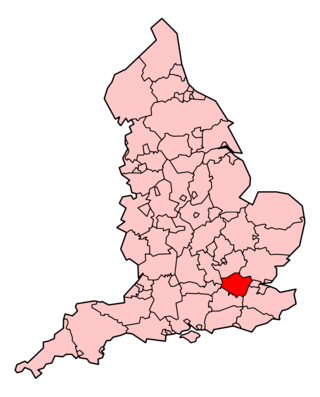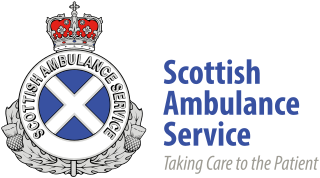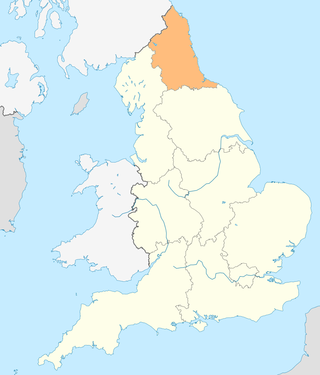Related Research Articles

A paramedic is a healthcare professional trained in the medical model, whose main role has historically been to respond to emergency calls for medical help outside of a hospital. Paramedics work as part of the emergency medical services (EMS), most often in ambulances. They also have roles in emergency medicine, primary care, transfer medicine and remote/offshore medicine. The scope of practice of a paramedic varies between countries, but generally includes autonomous decision making around the emergency care of patients.

The London Ambulance Service NHS Trust (LAS) is an NHS trust responsible for operating ambulances and answering and responding to urgent and emergency medical situations within the London region of England. The service responds to 999 phone calls across the region, and 111 phone calls from certain parts, providing triage and advice to enable an appropriate level of response.

The Northern Ireland Ambulance Service is an ambulance service that serves the whole of Northern Ireland, approximately 1.9 million people. As with other ambulance services in the United Kingdom, it does not charge its patients directly for its services, but instead receives funding through general taxation. It responds to medical emergencies in Northern Ireland with the 300-plus ambulance vehicles at its disposal. Its fleet includes mini-buses, ambulance officers' cars, support vehicles, RRVs and accident and emergency ambulances.

The Scottish Ambulance Service is part of NHS Scotland, which serves all of Scotland's population. The Scottish Ambulance Service is governed by a special health board and is funded directly by the Health and Social Care Directorates of the Scottish Government.

The Welsh Ambulance Services NHS Trust is the national ambulance service for Wales. It was established on 1 April 1998 and as of December 2018 has 3,400 staff providing ambulance and related services to the 3 million residents of Wales.

The South East Coast Ambulance Service NHS Foundation Trust (SECAmb) is the NHS ambulance services trust for south-eastern England, covering Kent, Surrey, West Sussex and East Sussex. It also covers a part of north-eastern Hampshire around Aldershot, Farnborough, Fleet and Yateley. The service was made an NHS foundation trust on 1 March 2011.

St John Ambulance is a volunteer-led, charitable non-governmental organisation dedicated to the teaching and practice of first aid and the support of the national emergency response system in England. Along with St John Ambulance Cymru, St John Ambulance Northern Ireland, and St John Scotland, it is one of four United Kingdom affiliates of the international St John Ambulance movement.

The North West Ambulance Service NHS Trust (NWAS) is the ambulance service for North West England. It is one of ten ambulance trusts providing England with Emergency medical services, and is part of the National Health Service, receiving direct government funding for its role.

The South Western Ambulance Service NHS Foundation Trust (SWASFT) is the organisation responsible for providing ambulance services for the National Health Service (NHS) across South West England. It serves the council areas of Bath and North East Somerset, Bournemouth, Christchurch and Poole Council, Bristol, Cornwall, Devon, Dorset, Gloucestershire, North Somerset, Plymouth, Isles of Scilly, Somerset, South Gloucestershire, Swindon, Torbay and Wiltshire.

Yorkshire Ambulance Service NHS Trust (YAS) is the NHS ambulance service covering most of Yorkshire in England. It is one of ten NHS Ambulance Trusts providing England with emergency medical services as part of the National Health Service it receives direct government funding for its role.

The South Central Ambulance Service NHS Foundation Trust (SCAS) is the ambulance service for the counties of Berkshire, Buckinghamshire, Oxfordshire and most of Hampshire. It is a foundation trust of the National Health Service, and one of ten NHS ambulance trusts in England. As of August 2022, SCAS is currently rated Inadequate by the CQC following multiple failings within the trust. SCAS is the only Ambulance Service in England to have received this rating.

The East of England Ambulance Service NHS Trust (EEAST) is an NHS trust responsible for providing National Health Service (NHS) ambulance services in the counties of Bedfordshire, Cambridgeshire, Essex, Hertfordshire, Norfolk and Suffolk, in the East of England region. These consist of approximately 6.2 million people across an area of 7,500 square miles (19,000 km2).

The Great Western Ambulance Service NHS Trust (GWAS) was a National Health Service (NHS) trust which provided emergency and non-emergency patient transport services to Bath and North East Somerset, Bristol, Gloucestershire, North Somerset, Swindon and Wiltshire, in South West England. It was formed on 1 April 2006 by the merger of the Avon, Gloucestershire and Wiltshire ambulance services. The ambulance service was acquired by neighbouring Foundation Trust South Western Ambulance Service (SWASFT) on 1 February 2013.

The North East Ambulance Service NHS Foundation Trust (NEAS) is an NHS foundation trust responsible for providing NHS ambulance services in North East England. Headquartered in Newcastle upon Tyne, NEAS provides emergency medical services to the metropolitan boroughs of Newcastle upon Tyne, Gateshead, North Tyneside, South Tyneside and City of Sunderland; the ceremonial counties of County Durham and Northumberland; and the area of North Yorkshire commonly known as Teesside. NEAS was formed on 1 July 2006, following the merger of the existing North East Ambulance Service with the Tees division of the Tees, East and North Yorkshire Ambulance Service (TENYAS). Northumbria Ambulance Service and County Durham Ambulance Service had previously merged on 1 April 1999.

The West Midlands Ambulance Service University NHS Foundation Trust (WMAS) is responsible for providing NHS ambulance services within the West Midlands region of England. It is one of ten ambulance trusts providing England with emergency medical services, and is part of the National Health Service.

Emergency medical services in the United Kingdom provide emergency care to people with acute illness or injury and are predominantly provided free at the point of use by the four National Health Services (NHS) of England, Scotland, Wales, and Northern Ireland. Emergency care including ambulance and emergency department treatment is only free to UK residents and a charge may be made to those not entitled to free NHS care.

Emergency medical personnel in the United Kingdom are people engaged in the provision of emergency medical services. This includes paramedics, emergency medical technicians and emergency care assistants. 'Paramedic' is a protected title, strictly regulated by the Health and Care Professions Council, although there is tendency for the public to use this term when referring to any member of ambulance staff.

The East Midlands Ambulance Service NHS Trust (EMAS) provides emergency medical services, urgent care and patient transport services for the 4.8 million people within the East Midlands region of the UK - covering Nottinghamshire, Derbyshire, Leicestershire, Rutland, Lincolnshire and Northamptonshire. It was formed in 1999 by amalgamating several county ambulance services, and in July 2006 was dissolved and reformed under the same name as part of a nationwide reorganisation of ambulance service provision.
Essex & Herts Air Ambulance Trust (EHAAT) is a charity air ambulance service providing a free, life-saving Helicopter Emergency Medical Service (HEMS) for the critically ill and injured of Essex, Hertfordshire and surrounding areas.
The States of Jersey Ambulance Service (SJAS) is managed by the Justice and Home Affairs department.
References
- 1 2 "Careers in the ambulance service: Emergency care assistant". NHS Careers. Retrieved 3 October 2014.
- ↑ Rainey, Sarah; Adams, Stephen (7 November 2011). "Emergency Care Assistants replace paramedics for 999 calls as cuts hit ambulance trusts". The Daily Telegraph . Telegraph Media Group. Archived from the original on 7 November 2011. Retrieved 15 January 2015.
- 1 2 "Job profiles:Emergency care assistant". National Career Service (UK). Retrieved 12 January 2015.
- ↑ Andalo, Debbie (20 February 2013). "How to get ahead in … the paramedic service". The Guardian . Guardian Media Group . Retrieved 10 February 2015.
- ↑ "National profiles for ambulance services" (PDF). NHS Employers. Retrieved 22 January 2015.
- ↑ "Emergency cover changes confirmed". BBC News . BBC. 25 January 2005.
- ↑ "Ambulance crews' anger at changes". BBC News. BBC. 9 May 2007.
- ↑ Triggle, Nick (11 December 2007). "Ambulance shake-up 'poses risks'". BBC News. BBC.
- ↑ "Unison angry over training scheme". BBC News. BBC. 7 August 2008.
- ↑ "Volunteers relied on as 999 crews". BBC News. BBC. 9 November 2009.
- ↑ "Yorkshire Ambulance Service proposes workforce changes". BBC News. BBC. 7 January 2013.
- ↑ "East Midlands ambulance union criticises staff policy". BBC News. BBC. 19 March 2013.
- ↑ "Emergency cover changes confirmed". BBC News. BBC. 19 December 2014.
- ↑ "Chelmsford lifesaver first in Mid-Essex to complete enhanced lifesaving skills course" (Press release). East of England Ambulance Service NHS Trust (EEAST). 25 November 2014. Archived from the original on 11 February 2015. Retrieved 11 February 2015.
- ↑ "Become a paramedic". College of Paramedics . Retrieved 12 January 2015.
- ↑ "ECA To Paramedic Frequently asked Questions". East Midlands Ambulance Service. June 2014. Retrieved 22 January 2014.